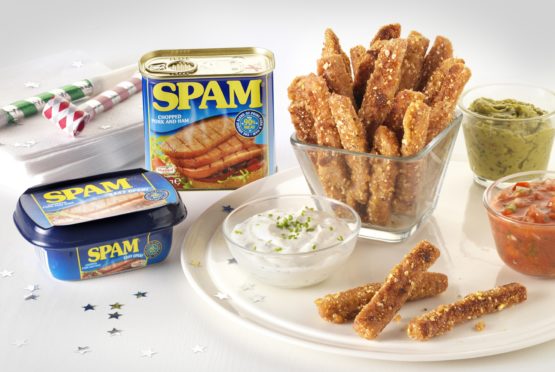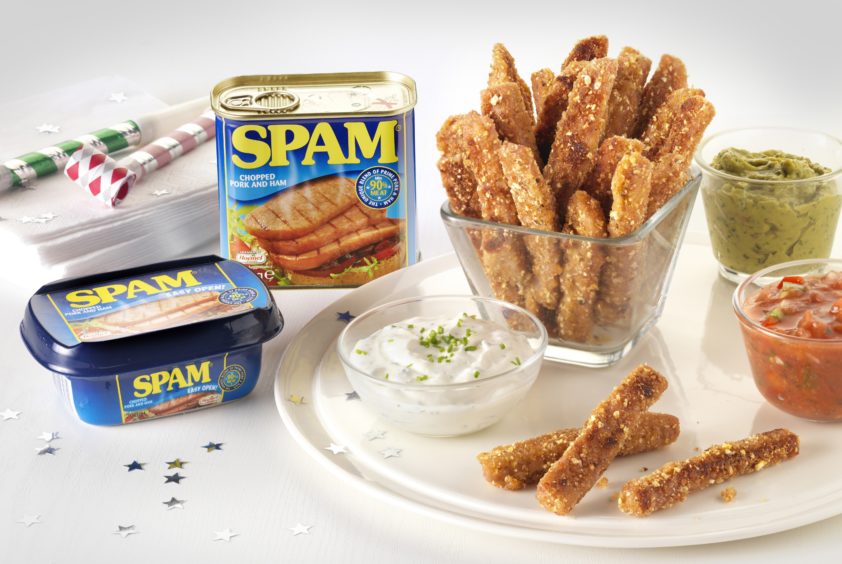It gained worldwide popularity after originating in 1937, largely feeding the nation during the Second World War. But, as the 75th anniversary of VE day approaches, Susan Welsh finds some ways to give the old favourite a modern twist…
If there is one food that evokes the spirit of the Second World War, it’s SPAM.
The store cupboard favourite, made from a minimum of 90% shoulder pork and leg ham, first came to the UK in 1941. It fed the nation throughout the war and became a staple food for many households for decades to come.
Back then SPAM was regularly used to make sandwiches, stews and fritters. Today it’s used in a variety of recipes.
With the 75th anniversary of VE Day taking place on May 8, we thought it would be a good time to pay homage to this classic meat, which celebrates its 80th birthday here next year.
So grab a can from the cupboard, get cooking and raise a glass to those who gave so much during the war.
SPAM brunch frittata
Ingredients
(Serves 4)
- 1 x 340g can SPAM, cut into half inch cubes
- 6 large eggs
- 4 tbsp milk
- 2 medium tomatoes, quartered, deseeded and drained on kitchen paper
- 30g Cheddar cheese, grated
- 1 knob butter, or a little vegetable oil
- Salt and freshly ground black pepper
Method
- Place the eggs into a mixing bowl, add the milk, salt and pepper and combine well with a fork.
- Place the cubes of SPAM into a hot dry frying pan (size approximately 23cm) and fry until golden and lightly browned.
- Add the butter or oil into the pan and pour in the egg mix.
- Keep bringing the cooked egg and SPAM mix into the centre of the pan.
- Swirl it around until the egg has formed a ‘pancake’ but is still soft on the top, and the SPAM is evenly mixed through.
- Scatter on the tomatoes, followed by the grated cheese.
- Put the pan under a hot grill until the cheese is golden and bubbling and the egg is finished cooking.
- Cut into slices and serve hot straight from the pan.
Smokey SPAM and popcorn goujons
Ingredients
(Makes around 30 goujons)
- 1 x 340g can of SPAM Chopped Pork and Ham, cut into strips
- 100g white breadcrumbs
- 40g salted popcorn
- 1 rounded tsp smoked paprika
- 1 large egg, beaten
- 50g plain flour
- Vegetable oil for frying
Method
- Break up the popcorn and put it in a medium bowl with the breadcrumbs and smoked paprika. Mix well.
- Put the flour in a separate shallow bowl and the beaten egg into another.
- Dip the SPAM strips in flour, completely covering them, then dip in the beaten egg and finally coat in the smokey breadcrumbs, pressing the breadcrumbs into the meat.
- Repeat until all the goujons are coated.
- Place the goujons on a baking tray and leave in the fridge for a few hours or overnight.
- Cover the base of a frying pan with oil and fry the goujons on each side until golden.
- Do not overfill the pan, and cook in batches.
Serve with various dips.
More recipes can be found at www.spam-uk.com
FIVE THINGS YOU NEVER KNEW ABOUT SPAM
- There is an official SPAM Museum located in Austin, Minnesota which attracts thousands of visitors every year.
- Celebrity SPAM fans include Bruno Mars, James May and Richard Madeley.
- In South Korea, SPAM is considered a gourmet delicacy and is often given as a gift.
- Between 1941 and 1945, more than £100 million pounds worth of SPAM was shipped abroad to feed allied troops.
- In 2006, a limited-edition SPAM brand variety called Stinky French Garlic was launched in supermarkets to celebrate the opening of SPAMALOT the Musical in the UK. Python Eric Idle helped to design the can.



